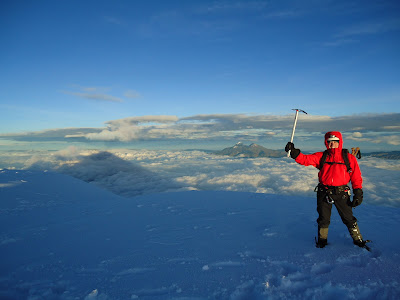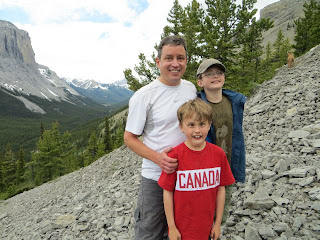 |
| Pocaterra Cirque |
There we were, Mack, Michael and myself, a stone's throw from five big horn sheep. All I could think was, "Wow, that beats the larches turning gold any day."
 |
| Golden larch needles |
 |
| Bighorn sheep out people watching |
The trail veers off of the interpretive trail shortly after leaving the parking lot. (A couple weeks earlier instead of veering left we'd gone straight on the kid's hike to Ptarmigan Cirque.) After gaining about 60 m, it drops out of the trees into a lush meadow with Grizzly Ridge to the left, views of the Highwood Valley to the right, and golden larches straight ahead. After passing a very small lake, the trail re-enters the trees and gains another hundred meters or so. Three kilometers from the parking lot the trail splits with Pocaterra Ridge to the right and Grizzly Col to the left. We went left for a few minutes, dropped our packs and had lunch.
We explored, climbed on rocks and made another bigfoot video for an hour, then headed back. It was then that we encountered the bighorn sheep. They were about 10 m off the trail, and didn't seem bothered in the least by us. Although the boys had seen bighorn sheep up close through the car window, it was the first time they'd seen them on the trail. It was also the first time I've seen them that close on the trail. I've seen them from a distance--just the week before we'd seen a few from the ridge, grazing a couple hundred meters below us--but I've never walked right past them. It was one of those shared experiences with Mack and Michael that I`ll remember for the rest of my life.
Another reason I'll remember Pocaterra Cirque is for something Mack said. At the bottom of a steep section where the trail was hard packed dirt and offered little traction, he told me: "Dad, I didn't have any trouble coming down that. All this hiking must be working." Forget the bighorn sheep and the larches. That's what hiking with kids is all about.
Distance: About 6 km return
Elevation gain: About 150 meters
Hiking/Exploring Time: 3 to 5 hour
Directions: Head west on the Trans-Canada. Take the turnoff for Kananaskis Country/Highway 40. Drive south for about 67 km to Highwood Pass parking lot. Head down the trail for a minute or two until you come to an unmaintained trail on the left. Take it.
Click here for a driving map.
 |
| Pocaterra Ridge in the background |
 |
| The trail to Pocaterra Cirque below Grizzly Ridge |
 |
| We keep running into bigfoot... |






































